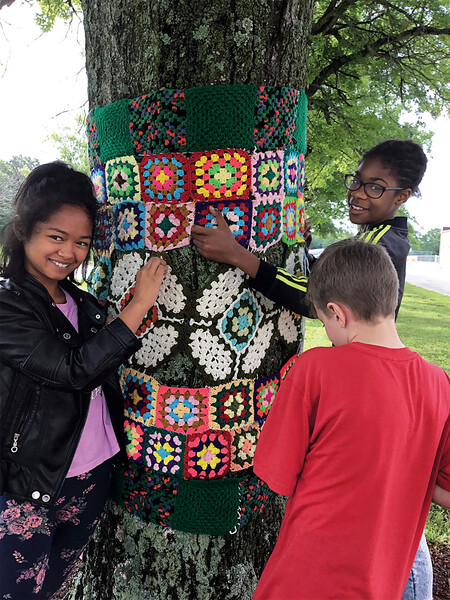Student after student filed into my art classroom, twitching with excitement, asking some variation of, "Are we working on the yarn bomb today?"
Their excitement was exactly what I'd hoped for after introducing these 5th graders at Partridge Elementary School in Missouri to the concept of "craftivism" and social justice. Craftivist and author Betsy Greer defines craftivism as "a way of looking at life where voicing opinions through creativity makes your voice stronger, your compassion deeper, and your quest for justice more infinite." When our school district announced that diversity would be our strategic focus for the 2017–2018 school year, I realized that a large-scale, joint art project would be a great way for my students to learn about this issue.
To start, my students and I discussed what types of art projects we might do to incorporate diversity and social justice. The majority voted for the idea of a yarn bombing. A form of fiber graffiti, the practice of yarn bombing gained popularity during the early 2000's. Adorning public spaces with knit or crochet is a gentle way to reclaim an area or bring attention to a cause. In this case, our cause was unity. We hoped our carefully stitched-together knit and crochet pieces of all sizes, shapes, and colors would reinforce the concept that people of all races, ages, genders, and abilities can contribute to the greater good of society. As one of my 5th grade boys observed, "A yarn bomb is a perfect way to celebrate diversity because it comes in so many different colors and sizes. It can represent all of the different people in the world."
We determined the installation site would be the front grounds of our school, including five large trees and two hand railings. An early problem arose: How can we do a yarn bomb when most of the students don't know how to knit or crochet? It takes a while to become proficient in either of these crafts. We worked around this by finding secondhand afghans in thrift stores and other places and taking them apart. We also asked family and community members for donations. A steady stream of yarn, knit, and crochet pieces began to come in.
In the meantime, a few students who did know these crafts began teaching the others how to finger knit or knit and crochet with needles. As the students worked, they considered pattern, color, and repetition with diversity in mind. Discussions of ethics and justice wound their way through the project. "Is yarn bombing legal? Could we get in trouble for installing a yarn bomb?" These questions motivated research into the legalities and purpose of craftivism.
I also watched my student artists become scientists as they asked questions and formed hypotheses. Could it be harmful to trees to cover sections of them with knitted and crocheted fabric for an extended period? What will happen to the yarn if it rains or gets wet and freezes? Our research revealed that both acrylic and organic yarns would hold up to midwestern weather, at least for the duration of the installation. Students concluded that it would be healthier for the trees, as well as more comfortable for themselves, if the installation took place in the spring.
With support of the administration, each 5th grade student took part in installing the project, which we called "Yarn Bomb for Diversity," on May 21, 2018, shortly before the end of the school year. The large, colorful display quickly caught the attention of students, staff, families, and community members. To the delight of my students, their project was also featured twice in the district newsletter and photos were posted to the school's social media accounts.
Far from ending at the studio door, arts education should challenge students to view themselves as important members of society. Arts can foster the development of creativity, cross curricular borders in meaningful ways, and contribute to the development of skills needed to be happy and productive citizens. In our case, my students felt that the collaborative aspects of this project contributed greatly to its success. They said the different yarns, patterns, and colors emphasized the strength of diversity and, perhaps most importantly, in the words of one student, "It was fun knowing that we were doing something … to make the world a better place."
Students in Sheryl Lamme's art class attach knit and crochet pieces to a tree on school property as part of a colorful "yarn bombing" project that celebrated diversity.
Photo courtesy of Sheryl Lamme









